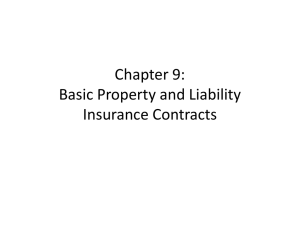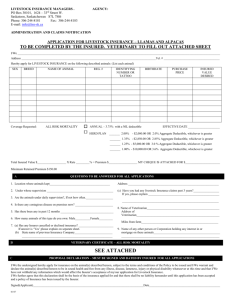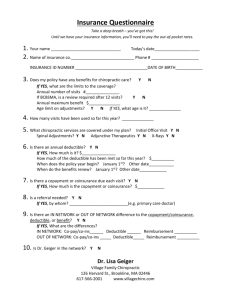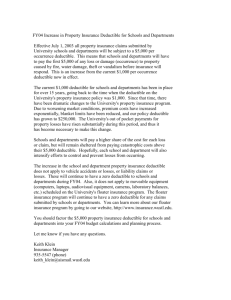DEDUCTIBLES IN INDUSTRIAL FIRE INSURANCE
advertisement
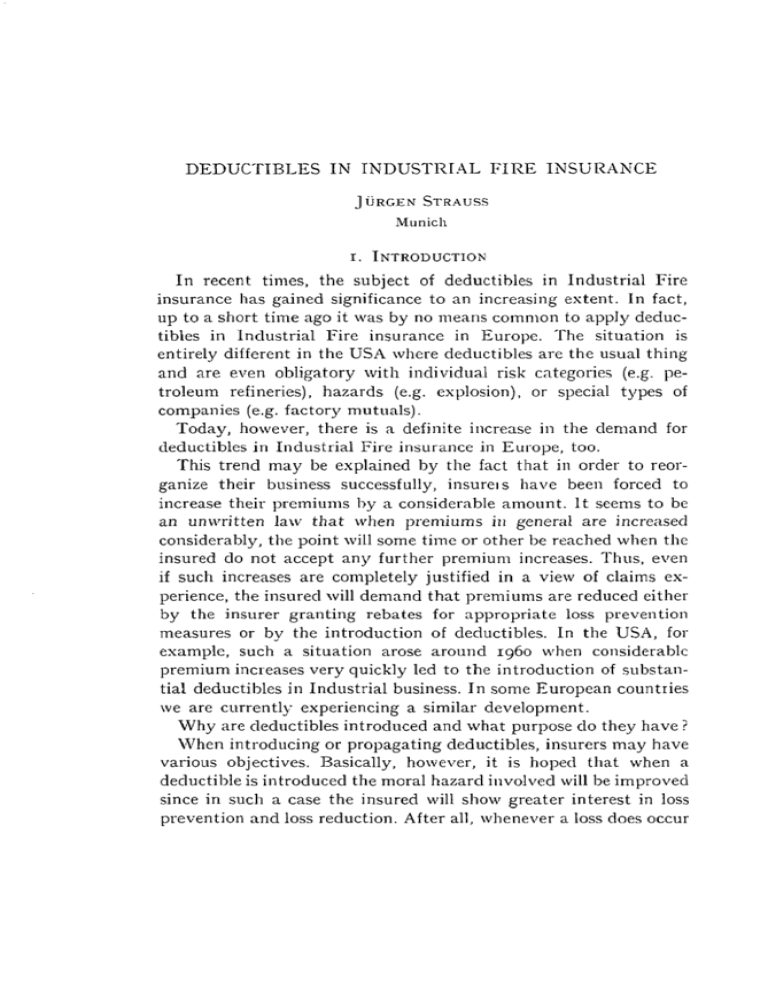
D E D U C T I B L E S IN I N D U S T R I A L F I R E INSURANCE
] URGEN STRAUSS
Municll
I. INTRODUCTION
In recent times, the subject of deductibles in Industrial Fire
insurance has gained significance to an increasing extent. In fact,
up to a short time ago it was by no means common to apply deductibles in industrial Fire insurance in Europe. The situation is
entirely different in the USA where deductibles are the usual thing
and are even obligatory with individual risk categories (e.g. petroleum refineries), hazards (e.g. explosion), or special types of
companies (e.g. factory mutuals).
Today, however, there is a definite increase in the demand for
deductibles in Industrial Fire insurance in Europe, too.
This trend may be explained by the fact that ill order to reorganize their business successfully, insurels have been forced to
increase their l)remiums hy a considerable amount, it seems to be
an unwritten law that when t)remiums in general are increased
considerably, the point will some time or other be reached when the
insured do not accept any further premium increases. Thus, even
if such increases are completely justified in a view of claims experience, the insured will demand that l)remiums are reduced either
by the insurer granting rebates for appropriate loss prevention
measures or by the introduction of deductibles. In the USA, for
example, such a situation arose around z96o when considerable
premium increases very quickly led to the introduction of substantial deductibles in Industrial business. In some European countries
we are currently experiencing a similar development.
Why are deductibles introduced and what purpose do they have ?
When introducing or propagating deductibles, insurers may have
various objectives. Basically, however, it is hoped that when a
deductible is introduced the moral hazard involved will be improved
since in such a case the insured will show greater interest in loss
prevention and loss reduction. After all, whenever a loss does occur
DEDUCTIBLES 1N INDUSTRIAL FIRE INSURANCE
379
under a policy with a deductible, tile insured will have to bear p a r t
of the financial burden himself.
Another very i m p o r t a n t point is t h a t when a deductible is applied,
tile insurer will not have to settle small losses a n y m o r e - - w h i c h
obviously relieves him of a considerable a m o u n t of work. One
must therefore appreciate that the " v a l u e " of a deductible c a n n o t
only be measured in terms of the a m o u n t involved. Rather, one has
to make allowance for the s e t t l e m e n t e x p e n d i t u r e saved by the fact
t h a t the insurer is not liable for minor losses. A f u r t h e r a d v a n t a g e is
t h a t if a deductible is applied without a p r e m i u m reduction, it can
be used to improve the s t r u c t u r e of under-rated risks, as in such
cases the deductible constitutes an indirect p r e m i u m increase.
On the other hand, the a d v a n t a g e offered to the insured is tlhat
the premium he must pay to obtain insurance coverage is reduced.
T o g e t h e r with the policy of granting rebates to the insured w h e n e v e r
he takes effective loss p r e v e n t i o n measures, deductibles are therefore suitable for helping an insurer keep his m a r k e t and p r e v e n t
good risks front moving over to outsider markets from the local
market. Similarly, by avoiding premium increases through the
introduction of deductibles, the insurer can keep his business attractive for the policyholder, thus p r e v e n t i n g a n y trends towards
self-insurance. Finally, it should also be considered t h a t w i t h o u t
deductibles, it would be entirely impossible in some cases to cover
severe risks.
2. DEFINITION OF A DEDUCTIBLE AND THE D I F F E R E N C E B E T W E E N
DEDUCTIBLES AND EXCESS OF LOSS INSURANCE
A deductible can be defined as the participation of the insured
in a loss up to a certain limit agreed on in advance.
Although this definition is v e r y closely related to the definition
of Excess of Loss insurance, the basic difference between the two is
that Excess of Loss insurance is usually concluded on a first loss
basis where the sum insured does not fully correspond to the value
of the risk, whereas in the case of a deductible the traditional
concept of full value insurance with its under-insurance clauses
remains unaffected.
Speaking of deductibles as such, we m a y basically distinguish
between a m o u n t deductibles and time deductibles. Referring to
380
D E D U C T I B L E S IN I N D U S T R I A L F I R E I N S U R A N C E
a m o u n t deductibles first of all, the most i m p o r t a n t category we
have here is t h a t of tile so-called " p u r e " deductible where the
insurer does not provide a n y indemnification at all for losses below
the a m o u n t agreed on, while when indemnifying losses exceeding
t h a t amount, he will be responsible for the claim minus tlm deductible amount. Vv'hen applying a n o t h e r kind of deductible, the socalled franchise, the insurer is required to i n d e m n i f y a n y losses
exceeding the agreed limit in full (i.e. he cannot deduct the insured's
share), while the insured is responsible for any losses lower t h a n the
a m o u n t agreed on. The reason why such franchises are not as common as " p u r e " deductibles is most p r o b a b l y because policyholders
always feel r a t h e r a n n o y e d when t h e y have to pay losses just below
the fixed amount. The situation is similar when one applies the socalled disappearing deductible which is a kind of combination of a
" p u r e " deductible and a franchise. The special characteristic of this
disappearing franchise is t h a t here the insured is liable for all losses
up to the a m o u n t agreed on (which makes this the same as a " p u r e "
deductible), while the insured's share is reduced as the a m o u n t of
the claim increases so that when a certain limit is reached, the
insured does not have to p a y a n y t h i n g at all. It can be seen, therefore, t h a t of the various kinds of a m o u n t deductibles, the deductible
as such is the easiest to use. Compared with a franchise, it offers the
a d v a n t a g e of being non-manipulatable, so t h a t indemnification
does not depend on whether a loss has exceeded the a m o u n t fixed or
not.
W h e n applying a time deductible, the deductible is defined in
units of time. I t is obvious therefore that such deductibles are only
possible with an insurance where a loss occurs over a certain period
of time and is not an instantaneous event. Thus, a time deductible is
quite suitable in Fire Loss of Profits insurance. When applying a
time deductible, we must again distinguish between two different
t y p e s : First of all there is the " p u r e " time deductible as such where
the insured is responsible for t h a t share of a loss c o n s t i t u t e d b y the
period agreed on, while secondly we also have p r o p o r t i o n a t e time
deductibles where the insured pays a certain percentage in the
overall loss resulting from the ratio between the time of the deductible and the duration of the loss as a whole. As p r o p o r t i o n a t e time
deductibles c a n n o t be m a n i p u l a t e d in a n y way, they appear
DEDUCTIBLES IN INDUSTRIAL FIRE INSURANCE
381
preferable to standard time deductibles where the insured has the
possibility in some cases of limiting the amount of a claim for, say,
the first three days, thus increasing it for the following period and
manipulating loss development.
As there are still considerable difficulties in calculating rebates for
time deductibles, we shall confine ourselves to "pure" amount
deductibles in the following.
3. REBATE CALCULATION WITH DEDUCTIBLES
Assuming that the basic t)reinium provided for in the tariff is
correct, the question of calculating the rebate is of first and foremost
importance when introducing a deductible. With this in mind, it
should therefore be noted that the gross premium charged by the
insurer is made up of the following components:
a) the risk premium required for covering claims expenditure on the
basis of the equivalence principle;
b) the cost surcharges (and here it is sufficient in the present
context to distinguish between the cost of claims settlement and
the cost items which are dependent and independent of the
premium); and
c) the profit margin.
By introducing a deductible, three factors in this calculation
model are influenced : the risk premiunl, the costs for settling claims,
and the costs which are a function of the premium.
In the following, I would therefore like to examine these three
factors ill greater detail.
3.I. Risk premium
3.1.1. Calculation of the loss elinaination ratio
The degree to which the risk premium call be reduced when a
deductible is introduced depends basically on the so-called loss
elimination ratio. This is the factor which indicates which percentage in claims expenditure--in terms of overall claims volume--the
insurer is able to save by introducing the deductible. The loss
382
DEDUCTIBLES
IN INDUSTRIAL
FIRE INSURANCE
elimination ratio, which shall here be referred to as a, can be determined as soon as the distribution of claim a m o u n t is k n o w n '
..I
J" xf(x) dx + A J" f(x) dx
o
a
A
=
(I)
f x f (x) dx
o
Note: a
A
= loss elimination ratio
= deductible
f(x) = distribution of claim anaount X
It is assumed in this formula (I) that the a m o u n t of any individual
loss is i n d e p e n d e n t of claim f r e q u e n c y (i.e. the n u m b e r of claims
related to the n u m b e r of risks observed during a given period).
Up to a short time ago, it was hardly possible in G e r m a n y to obtain a n y representative statistics showing the distribution of claim
amounts. It must therefore be appreciated that a n u m b e r of major
Industrial Fire insurers in G e r m a n y have participated in a special
statistical s u r v e y on the basis of which all risks and claims prevailing
in some selected fields of i n d u s t r y have been compiled over a
n u m b e r of years. In so doing, information has been provided on the
sums insured, PM~Ls, and premiums as far as the relevant risks are
concerned, while at the same time code figures have been determined in accordance with the breakdown of the G e r m a n Fire tariff
into classes of risks. The overall objective in this v e n t u r e was to
l)rovide a complete s u r v e y of the each individual risk and not just
a s t u d y of overall treaties. Losses were then registered separately
on the basis of the claim a m o u n t s for each individual risk. This
statistical s u r v e y has been provided for Fire and Fire Loss of
Profits separately.
When selecting the individual fields of i n d u s t r y to be included in
this investigation, it was decided to attach special i m p o r t a n c e to
those risk categories which, according to German statistics, are
characterized by considerable differences in terms of claim freq u e n c y and average claim amounts. This was done because it can
be assumed t h a t the loss elimination ratio depends to a considerable
e x t e n t on these two factors of claim frequency and average claim
amounts. A first analysis of the material obtained has indicated as
D E D U C T I B L E S IN INDUSTRIAl, FIRE INSURANCE
38,.3
an initial result that the distribution of clailns may be approximated
by using a log-normal distribution. This applies particularly to low
claim amounts. On the basis of a logarithmic probability paper,
Fig. I provides an example of such an approximation by showing
the values obtained for Fire and Fire Loss of Profits for all of the
statistical material (i.e. not broken down according to risk categories).
9998
99.95
999
99.8
JFire
99.5
99
jJ
98
97
1
60
,o
7 .
30,'
I
10
I
I
I
I
25
50
100
250
500
1000
Claim
Amount
Fig. t. D i s t r i b u t i o n of c l a i m a m o u n t s in I n d u s t r i a l F i r e a n d F L O P .
As is to t)e expected, the Za test indicates that the hypothesis
that the claim distribution is a log-normal distribution may not be
rejected with a statistical reliability of 9o0/0. Also, this result ties
up very weU with the observations made by G. Ferrara (see References [i]) who has shown oll the basis of material compiled in Italy
that claims distribution can be approximated quite effectively by
way of a log-normal distribution. (It should nevertheless be noted
384
DEDUCTIBLES
IN INDUSTRIAL
FIRE
INSURANCE
at this point t h a t the material compiled by G. Ferrara is representative of claim amounts far lower than the claim a m o u n t s in the
material compiled in Germany.)
If, therefore, we state on the basis of equation (I)
log c ~
( l o g :z:-~) e
f(x)
1/~
-
with the expected value E(log X)
= c~, the following two integrals
log e
I~(G) -- i / ~
Iz(A)
2cr2
x e
(2)
= ~ and the variance De(log X)
must be solved:
,:
(log z--:)~
S e
2°~"
dx
,4 log e f -I
=
e
aog2~..z-~)______~
dx
x
By way of some substitutions, it can be shown t h a t
~2('n '°)0~+2"~In '°
(log ~ - - ~
)
It(G) = e
2
••
-e In lO
and
I~_(A)
A(I
@
~
)
Here, • is tile distribution function of the (o.z) normal distribution :
I
¢,(x)-
1/~
~
t2
-.~
-~S e " (tl
We then obtain the following equation for the loss elimination
ratio a :
a(A)=. (
oln o)+
(3)
It is obvious of course that the loss elimination ratio determined
by way of these equations cannot be applied to all risk categories. In
fact, even within one and the same class of risk, we must distinguish
in terms of rebate calculations between large and small risks considering t h a t if one applies a deductible of DM Ioo,ooo.-- for a small
object insured, most losses will not have to be passed on to the
DEDUC'FIBI.I~S IN INDUSTRIAL 17IRE INSURANCE
~8 5
insurer, whereas if the same deductible is applied to a large object
in the same class of risk, it might only cover small partial losses. In
order to calculate a suitable deductible rebate, the insurer must
determine the loss elimination ratio on the basis of homogeneous
classes of risk--homogeneous not only in terms of the type of risk
invoh, ed, but also in terms of risk magnitude. This is precisely
where the problem arises in Industrial Fire insurance, where it is
extremely difficult to form homogeneous risk classes in the way just
mentioned, particularly considering that the risk classes obtained
must be sufficiently reliable statistically in spite of the considerable
fluctuations to be expected within the framework of overall claims
experience. In the following it shall therefore be at t em pt ed to show
which individual factors in the material available were found to
definitely have an influence on the loss elimination ratio, using
statistical fitting methods.
3.I.2 Dependence of the loss elimination ratio on the absolute
amount of the deductible.
Fig. 2 shows how tile loss elimination ratio increases in Industrial
Fire and F L o P as tile deductible (expressed in DM) of tile overall
material compiled increases.
LO~ elimination ratio
Fife
FLoP
/
I
I
I
I
I
I
25
.50
100
250
500
1.000
~
Deductible
in D M 1 0 0 0
Fig. 2. Dependcnce of the loss e l i m i n a t i o n r a t i o on the a b s o l u t e a m o u n t of
the clcductibte.
386
DEDUCTIBLES
iN INDUSTRIAL
FIRE
INSURANCE
This graph shows that in FLOP, tile rebate granted to the insured
in return for the same deductible a m o u n t must be much lower than
in Fire. This situation is easy to explain:
In FLOP, the average claim is much greater than in Fire so that
most F L o P claims exceed the deductible agreed upon quite considerably. The result of this n a t u r a l l y is t h a t the deductible only
suffices for a small percentage of claims.
Among the statistical material available, there were relatively
few large losses with a claim a m o u n t of more than DM z million,
even though experience shows t h a t in G e r m a n y such losses are b y
no rneans infrequent and in fact constitute the major proportion of
the total claims e x p e n d i t u r e incurred by German Industrial Fire
insurers. This obviously means t h a t as soon as one is confronted
with losses of such i m p o r t a n t magnitude, the statistical reliability
of the material analyzed is not very good. F o r this reason it m a y be
t h a t the log-normal distribution derived front the statistical material
will decrease to zero too quickly for high claim amounts, the result
of this being that the insurer will u n d e r e s t i m a t e the probability of
large losses. This drawback is already made evident b y Fig. ~ where
with the higher claim a m o u n t s in F L o P the empirically d e t e r m i n e d
figures cannot be a p p r o x i n m t e d so accurately with the log-normal
distribution. When calculating rebates to be granted to the insured
in return for deductibles, this would mean that on the basis of the
log-normal distribution the loss elimination ratio would be overestimated, the rebate granted thus being too high. It is a wellknown fact that as soon as large losses are considered, the P a r e t o
distribution in Fire insurance provides a much better a p p r o x i m a t i o n
of the statistical material (see [o] and [3]), whereas of course the
P a r e t o distribution is not suitable for describing the claim distribution for small claims this being the claim category which is also
i m p o r t a n t when applying a deductible. It can be shown that as far
as large claims are concerned, a good a p p r o x i m a t i o n can be reached
b y applying the P a r e t o distribution. With this in mind, it is perhaps
a d v a n t a g e o u s to write the claim distribution f(x) for the purpose of
calculating the loss elimination ratio in the following manner:
c log e
(log ~ - ~ ) e
gel2
c
for :v < B
f(x) =
l / ~ a:~
-(4)
dx. - =
for :~: > B
DEDUCTIBLES
IN I N D U S T R I A L
387
FIRE INSURANCE
By suitable selection of the constants to be applied in this
equation, we can reach a standardization so that jr f ( x ) d x = z. I n
o
addition, the distribution density should be continuous at point B.
By introducing the claim distribution according to (4), the formula
for the loss elimination ratio becomes somewhat more complicated.
Assuming for example that B > A and ~ > 2, we then ol)tain
=
/~(l'(l°g~ - ~
crlnlo).-I- c A ( q , ( l ° g f f - - ~ ' ) - - ( l ) ( l ° g ~ - - ~ ' ) ) +
__
)
_
_
/~-¢t
- A
- d
1 3 - ~ +
l
+2
(5)
with
jt~ ~
C e ~'ln 104~-' ¢~CZ(lnlO)u
If B is mucll larger than the deductible, it is quite sufficient when
calculating the rebate to estimate the risk premium share for losses
larger than B. In the rebate calculation, the loss elimination ratio
is then corrected accordingly by applying it not to the entire risk
premium, but rather to a risk premimn which has been reduced
correspondingly. This procedure would be aPl)roximately in line
with the concept developed by Mr. Thonaazin (see [7]), who splits
up the risk premium into a basic portion for covering small and
medium-sized losses while applying a loading for large losses, such
loadings increasing with the size of the risk. When introducing
deductibles, ~'[r. Thomazin then only wants to grant a premium
rebate for the basic 1)remium and not for the loading mentioned.
3.r.3 Dependence of the loss elimination ratio on tile individual
branches of industry
The studies specified in the foregoing have been repeated for the
individual branches of industry. In so doing it was found that when
applying a fixed deductible, tile loss elimination ratio obtained
differs to a certain extent from one branch to another. In other
words, the claim distribution starts to take effect at different points.
388
DEDUCTIBLES IN INDUSTRIAL FIRE INSURANCE
i t is nevertheless advisable to arrange these individual branches of
i n d u s t r y in groups where the effect is more or less similar, simply because otherwise the scales for rebates would become too complicated
and coml)rehensive. [n the case of the risks studied and evaluated,
it was possible to form one group containing the steel and iron
industry, the automobile industry, the electrical i n d u s t r y and the
chemical industry. Another group is constituted by oil refineries and
the chipboard i n d u s t r y where a particularly large n u m b e r of major
and total losses m a y be expected and where partial damage is of
secondary significance only. Applying the same deductible, the loss
elimination l atio to be obtained here is only about one-third to onehalf of the ratio obtainable in the a b o v e - m e n t i o n e d risk categories.
This shows quite clearly that when granting rebates, we must
distinguish carefully between risks suseei)tible to large losses to a
considerable extent, and risks where the chance of a large loss is
not so great.
3.1. 4 Dependence of the loss elimination ratio on the PML
It has already been pointed out that the loss elimination ratio
does not only depend on the absolute a m o u n t of the deductible
granted, but also on the size of the risk. The most objective criterion
for assessing the size of a risk is of course the sum insured of the
individual complex. However, as it was not possible to the full
e x t e n t with. the statistical material studied to split up the figures
shown in each t r e a t y according to the individual complex, it was
decided to apply the P M L for the purpose of determining the "size
of a risk", even though we were n a t u r a l l y aware of the possil)ility
t h a t the PML is not fixed properly. We felt t h a t the possibility of
error resulting from this would be within acceptable limits, provided
risks with a relatively wide PML span would be put into one group.
It was then found t h a t if the deductible stays the same, the loss
elimination ratio will decrease when the PML increases (see Fig. 3
where the step-function of the loss elimination ratio we obtained
first has been fitted into a curve). [t is nevertheless interesting to
note that this dependence of the loss elimination ratio on the PML
was only found in risk groups with a comparable claim ratio ( =
claims in per cent of the premium) and thus having similar claim
experience. First of all, this dependence on the PML had been
D E D U C T I B L E S IN INDUS'FI/IAL F I R E I N S U R A N C E
389
covered up completely by the opposite dependence of the loss
elilnination ratio on claim experiellce (see 3.I.5).
b loss eliminaxion ratio
deductible
DM 100.000
deduct;hie
DM 25,000
I
10
I
50
I
100
Ii
PML in mio. DM
Vig. 3. D e p e n d e n c e of t h e loss e l i m i n a t i o n r a t i o o n t h e P M L .
One m a y say t h a t a p p r o x i m a t e l y the loss elimination ratio corresponding to a deductible of the a m o u n t A is a function of the size
of a risk, as is shown b y the following equation:
a(A) = g(X) • (log P M L ) -f~,
~ > o
Here, g(A) is a factor which depends on the general level of the
loss elimination ratio of the deductible A.
3.I.5 D e p e n d e n c e of the loss elimination ratio on claim experience
We have found t h a t the loss elimination ratio depends basically
on the claim ratio, i.e. on claim experience. The loss elimination ratio
obtained in treaties with favourable claim ratios is m u c h higher than
t h a t obtained in treaties with unfavourable claim ratios. On the
other hand, however, it must be realized that if treaties from the
individual branches of industry were only to be grouped on the basis
of the claim ratio criterion for each individual treaty, this would
constitute an e x t r e m e act of selection as in this case a t r e a t y will
v e r y quickly become a " b a d " t r e a t y as soon as losses start to occur.
The same characteristic as just described can however also be
observed if the criterion of " g o o d " and " b a d " claim experience is
related not to individual risks, but to individual branches of
390
D E D U C T I B L E S IN I N D U S T R I A L F I R E I N S U R A N C E
industry. This can be explained by tile fact that in treaties and
branches of industry with good claim experience and thus with a
low claim ratio there will still be a number of losses, but the size of
those losses and thus the average loss degree has proved to be low.
This in turn means that in the case of such risks the deductible can
absorb a larger proportion of claims than in the case of risks with
a high claim degree.
3.I.6 The problem of anti-selection
The situation just described now brings us to one of the most
important points in this discussion on deductibles, namely to the
problem of anti-selection. If deductibles are granted without proper
supervision in return for a rebate, there may be a danger of antiselection by the policyholders which is basically due to the heterogeneity of risks within the same risk and rating group. Of course,
it is quite obvious that in practice this heterogeneity can never be
avoided completely. Therefore there will be a danger that policyholders who generally have a bad claim record will not be interested
in obtaining a deductible while policyholders with a good claim
record will naturally want to have a deductible. In an extreme
case, this would mean that the insurer would be deprived of a
considerable amount of the premium by granting deductibles for
treaties that would hardly involve any claim expenditure anyway,
while on the other hand he would have to indemnify just about the
same losses in the case of bad risks where the insured is not interested
in obtaining a deductible. This shows quite clearly that the rebates
actually granted must be lower than the rebates originally calculated on the basis of the claim distribution observed in a heterogeneous class of risk.
As the problem of anti-selection results mainly from the fact that
the same average premium has to be paid by both "good" and
" b a d " risks within the same class of risks, the danger of antiselection will of course be much less if an experience rating is
provided for in the underlying tariff as in this way the risks involved
can be artificially made a little more homogeneous.
When calculating rebates, it must therefore be considered in this
context whether and to what extent the rating applied is already
based on experience rating. In addition, problems relating to the
D E D U C T I B L E S IN I N D U S T R I A L F I R E I N S U R A N C E
1391
credibility t h e o r y must also be considered, i.e. ill how far the claim
experience of one individual t r e a t y can be regarded as statistically
reliable within a group of heterogeneous risks. In terms of absolute
numbers, it is nevertheless difficult to cope with the problem of
anti-selection, particularly considering t h a t this problem relates to
the question of moral hazard. It is obvious, therefore, t h a t careful
underwriting can c o n t r i b u t e considerably to solving this problem.
In so doing, the claim experience so far and above ,all claim freq u e n c y and the average claim a m o u n t m a y provide very i m p o r t a n t
assistance in appreciating the clanger of anti-selection. For the
reasons already mentioned it is therefore essential not to specify
rigid rebate rates, but r a t h e r to use rebate band-widths for underwriting purposes.
Mathematical model investigations can of course be very helpful
in determining these rebate band-widths. In this context, [ would
like to refer to the work done by E. N e u b u r g e r (see [4]), who as far
as I know was the first to develop a m a t h e m a t i c a l model with the
help of which the effects of anti-selection can be assessed. In his
work, N e u b u r g e r assumes t h a t the portfolio involved is heterogeneous and can be split up into two more homogeneous classes of
risk; homogeneous in that both of these classes have a different
average claim degree, i.e. the average claim a m o u n t pet loss occurrence related to the sum insured (in practice, treaties with an average
claim degree of < d are grouped under class I, while treaties with
an average claim degree of > d come under class 2). In addition,
it is also necessary to know, or at least estimate, the distribution of
claim degrees in the two classes of risk. 13y proceeding on the basis
of different assumptions a b o u t the n u m b e r of treaties in the two
classes of risk and the n u m b e r of treaties in each class which take a
deductible, one can s t u d y the effects of anti-selection. If all the
insured in the class with the lower average claim degree then take
treaties with a deductible while all the insured in the class with the
higher claim degree have treaties without a deductible, we have the
case of excessive anti-selection.
3.2. The influence of the deduclible on costs
When calculating the loss elimination ratio, we know to what
e x t e n t the risk p r e m i u m m a y be reduced by applying a deductible.
